
Pitching IBM products to thousands of clients
My Role
Working with Directors of Design across IBM Cloud, Data and AI to craft their story for IBM’s largest global conference: think.
I used to produce international informercials for Beverly Hills Fitness where I learned how to identify and really sell value propositions in a compelling way from some of the best directors in the game. It’s no different from software, and in some ways, it’s even more critical to bring that kind of pizazz to a B2B technology space. Check out some of my mantras below to get an idea of what I think makes for compelling videos. IBM liked my work so much they asked me to lead a video production course, which had 52 attendees over 8 weeks. I was asked to put it on again the next quarter.
Produced by Dave Huber
think 2021
For the second year in a row, I was asked to Direct and Produce our org’s video keynote for IBM’s largest event of the year.
I worked one on one with the directors of design for IBM Cloud Pak for Data, Watson Knowledge Catalog, AI Applications, and the Chief Design Officer to help shape their message and delivery.
Scripting
Direction
Lead editor
Produced by Dave Huber
think 2020
Think is IBM’s global event highlighting the latest in technology and offerings. I was tapped to be our lead video producer for the virtual conference in 2020.
I worked with our Chief Design Officer and Directors of Design for Watson Moments, Public Cloud, Cloud Integration, and our VP of Design for Cloud Data and AI to shape our message and deliverable.
Scripting
Direction
Lead editor



What makes for compelling videos
Great design sits on the foundation of understanding your audience. Videos are the same.
Start with why
Don’t start with what. That’s less important. This is a reflection of evolutionary psychology. The oldest parts of our cognition understand why more than anything. It speaks to us deeply and is the best way to hook an audience.
Know your audience
Just like designers need to know their users, storytellers need to know their audience. For these conferences and events, it’s not potential users, but customers, decision makers, and executives in the audience. A great user experience is nice, but saving money, making money, and avoiding data breaches are even better.
Show don’t tell
This is the first principle of cinema and theater. Any time we’re watching someone talking about something, it’s more engaging to see the thing they’re talking about. Have a new cybersecurity protocol that predicts hacks? Sweet, let’s see it! Your teams have been working hard? Pics or it didn’t happen…
Don’t skip the problem
People don’t care about your solution until they care about the problem. Problems are best rooted in stories about people with irresistible characters who have something unique about them, a desire, and an obstacle. We like to root for these people and when we care about solving their real problems, we’re more interested in the solution being pitched.
Delivery is everything
People don’t care how much you know until they know how much you care. And people will forget what you said and did, but they will never forget how you made them feel. This is the hardest part for product teams selling their work, because not everyone is a thespian or an experienced public speaker. Casting is easy to overlook but can be the downfall for any demo.
Sell the benefits
Don’t sell the features, sell the benefits. This one is hard for product teams as they often have to shift into the mindset of sales. This is largely over-looked in design orgs because no matter how great the design is, if the product isn’t selling, it’s not a winner. This also helps designers hone in on what really matters in the product.
What I learned
Organize & Orchestrate
Orchestrating a global production with big names in a company requires consistent communication, clear expectations, and a delicate touch. Not everyone is comfortable being in front of the camera and selling things. Building a safe and encouraging relationship with each Design Director was really important to let them help guide their scripts and delivery.
Say it like you care
Small changes in the way sentences are phrased can have a huge impact on how it’s received by an audience. Even more: it’s not what we say, but how we say it. There’s a famous book for directing called “Directing Actors” by Judith Westin and in it she says, “don’t just ask someone to be more ‘excited’ or ‘happy’ or whatever other adjective you’re going for. It’s not very useful for the talent. Instead, give them an example like “I want you to read this next line like you just walked into a surprise birthday party for you.” That gives them something more tangible to work with. And another tip: people often mirror our emotions, so if you want someone to be expressive, ask the interview question in the tone you’re looking for.
